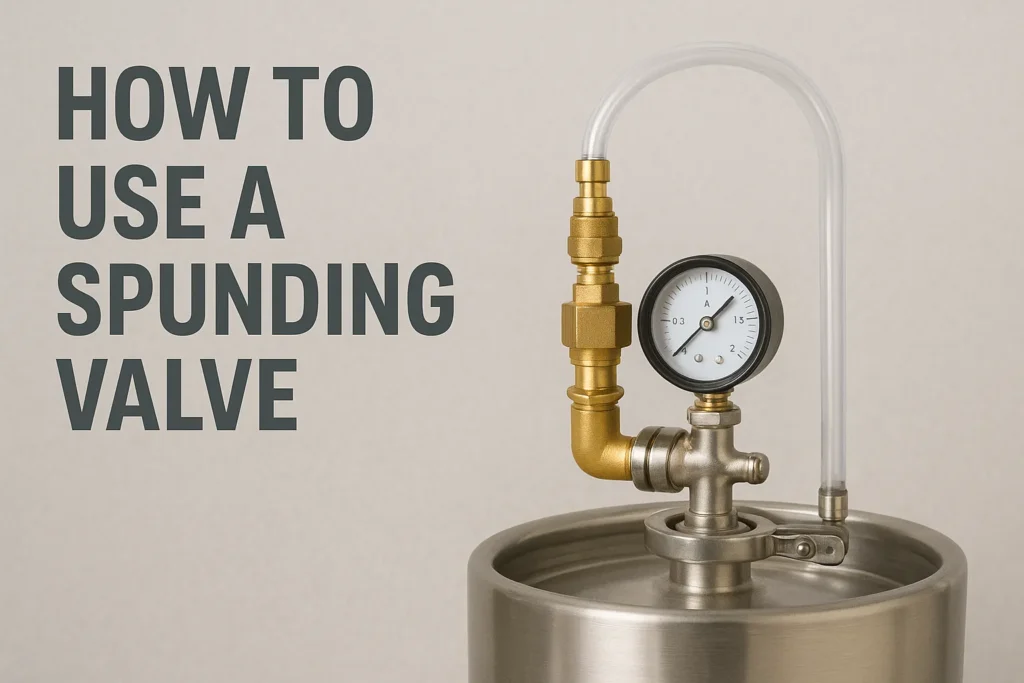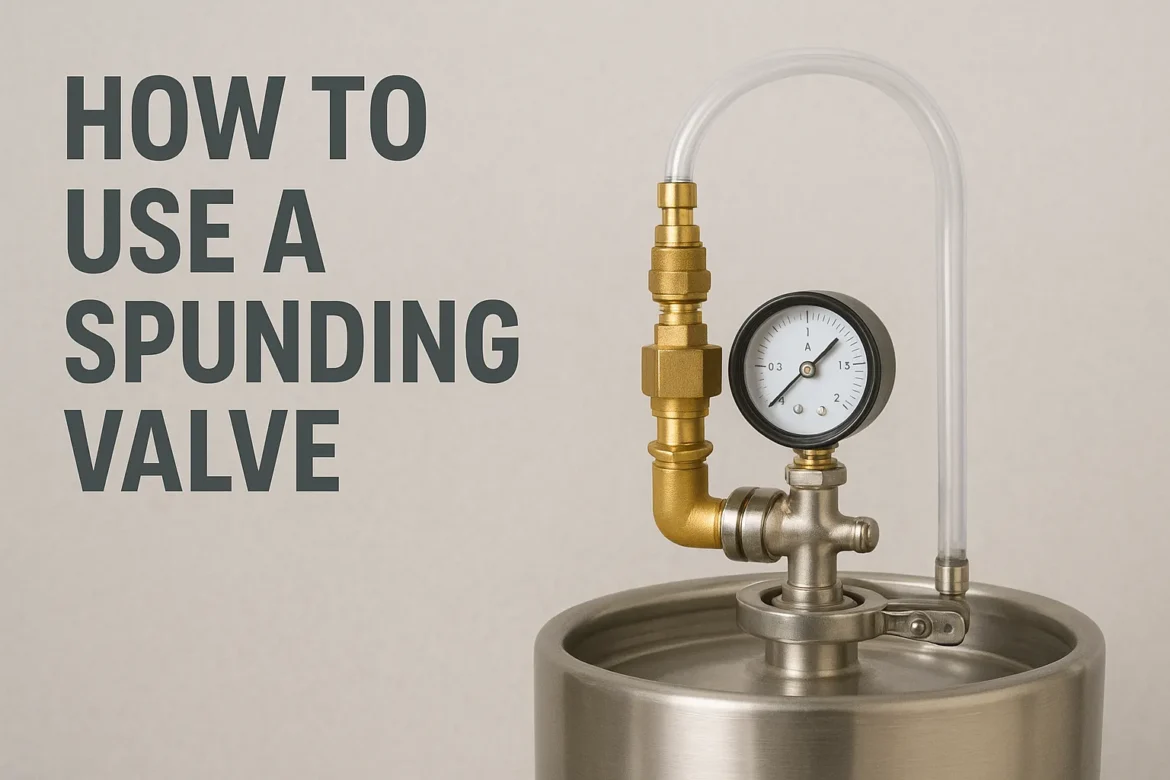Learn how to use a spunding valve for natural beer carbonation and pressure fermentation. Complete guide covering setup, adjustment, benefits, and troubleshooting for homebrewers and craft breweries seeking professional-grade fermentation control.

Mastering spunding valve usage represents a transformative step for any brewer seeking professional-grade fermentation control and natural carbonation capabilities. After experimenting with spunding valves across hundreds of batches over the past eight years, I can confidently state that proper spunding valve technique elevates beer quality through enhanced carbonation control, improved flavor retention, and sophisticated fermentation management that rivals commercial brewery practices.
My journey with spunding valves began with frustration over inconsistent carbonation and oxidized hop character in my IPAs, leading me to explore pressure fermentation techniques used by German lager producers. The revelation came when I discovered that spunding valves enable precise pressure control that not only naturally carbonates beer but fundamentally alters yeast behavior, ester production, and hop volatile retention in ways that dramatically improve final beer quality.
This comprehensive guide demystifies spunding valve operation through systematic explanation of setup procedures, pressure adjustment techniques, and advanced applications that enable brewers to harness fermentation pressure for superior results. From basic natural carbonation to sophisticated pressure fermentation protocols, understanding proper spunding valve usage opens doors to brewing techniques previously available only to commercial operations.
Whether you’re seeking consistent natural carbonation, exploring pressure fermentation benefits, or pursuing advanced brewing control, mastering spunding valve operation ensures reliable results while expanding your brewing capabilities beyond traditional atmospheric fermentation limitations.
Understanding Spunding Valve Principles and Function
A spunding valve regulates pressure in fermentation vessels by automatically venting CO2 when internal pressure exceeds the set threshold, enabling precise control over fermentation conditions while capturing natural carbonation produced by yeast activity.
Pressure Relief Mechanism and Design
The core function involves a spring-loaded diaphragm that opens when internal pressure exceeds the preset value, releasing excess CO2 while maintaining consistent vessel pressure throughout fermentation and conditioning phases.
Natural Carbonation Principles
Spunding enables natural carbonation by trapping yeast-produced CO2 within the fermentation vessel, allowing gradual absorption into the beer without requiring external CO2 injection or force carbonation procedures.
Pressure Effects on Fermentation
Controlled fermentation pressure influences yeast metabolism by suppressing ester production while maintaining clean fermentation character, enabling warmer lager fermentation temperatures without increased fruity flavors that would normally result from elevated temperatures.
Temperature and Pressure Relationships
Understanding the relationship between temperature and CO2 solubility guides proper spunding pressure settings, with higher temperatures requiring higher pressures to achieve equivalent carbonation levels compared to traditional cold conditioning approaches.
For comprehensive spunding valve techniques and advanced pressure fermentation strategies, explore the detailed resources at BrewMyBeer’s fermentation control guides, where professional brewing pressure management meets practical homebrewing applications.
How to Use a Spunding Valve Essential Equipment and Setup Requirements
Successful spunding valve implementation requires specific equipment configurations and safety considerations that ensure reliable operation while protecting both brewery equipment and beer quality.
Pressure-Rated Fermentation Vessels
Spunding requires pressure-capable fermenters including corny kegs, unitanks, or specially designed pressure fermenters rated for sustained pressures typically ranging from 15-30 PSI depending on application requirements.
Spunding Valve Types and Selection
Quality spunding valves feature adjustable pressure relief mechanisms with integrated pressure gauges that provide real-time monitoring and precise adjustment capabilities. Diaphragm-style valves offer superior accuracy compared to spring-loaded alternatives while maintaining consistent pressure control throughout fermentation.
Safety Equipment and Monitoring
Proper safety protocols include pressure monitoring equipment, relief systems, and appropriate vessel pressure ratings that prevent dangerous over-pressurization while ensuring reliable operation throughout fermentation cycles.
Connection Hardware and Accessories
Spunding valve connections require quality fittings including gas disconnects, barbed fittings, and appropriate hose connections that maintain airtight seals while enabling easy attachment and removal during operation.
Cleaning and Sanitation Considerations
Spunding valve components require systematic cleaning and sanitation procedures that prevent contamination while maintaining mechanical function and pressure accuracy throughout repeated brewing cycles.
| Equipment Component | Purpose | Pressure Rating | Key Features | Recommended Brands |
|---|---|---|---|---|
| Pressure Fermenter | Primary vessel | 15-30 PSI | Food grade, cleanable | Spike, Ss BrewTech |
| Spunding Valve | Pressure control | 0-30 PSI | Adjustable, accurate | Blowtie, Northern Brewer |
| Pressure Gauge | Monitoring | 0-30 PSI | Easy reading, reliable | Generic brass |
| Gas Disconnects | Connections | 30+ PSI | Quick connect/disconnect | Standard ball lock |
Step-by-Step Spunding Valve Setup Process
Proper spunding valve setup ensures reliable operation while establishing correct pressure settings that achieve desired fermentation conditions and carbonation levels.
Initial Pressure Calibration
Begin by pressurizing an empty vessel to your target pressure using a CO2 regulator, then attach the closed spunding valve to establish baseline pressure readings that enable accurate adjustment.
Valve Adjustment and Testing
Gradually open the spunding valve adjustment until gas begins venting, indicated by pressure gauge readings or audible gas release, then fine-tune the setting to maintain target pressure with minimal venting.
Verification and Fine-Tuning
Test spunding valve accuracy by monitoring pressure stability over time while making minor adjustments to achieve consistent pressure maintenance without excessive venting or pressure loss.
Connection and Sealing Verification
Ensure all connections remain airtight under pressure through systematic leak testing using soapy water or sanitizer solutions that reveal gas leaks requiring attention before fermentation begins.
Documentation and Baseline Establishment
Record initial settings and pressure relationships for future reference while establishing consistent procedures that enable repeatable results across multiple batches and brewing sessions.
Pressure Settings and Adjustment Techniques
Optimal spunding pressure depends on fermentation stage, temperature, and desired outcomes, with typical settings ranging from 10-25 PSI based on specific brewing objectives and style requirements.
Primary Fermentation Pressure Guidelines
Start with lower pressures during active fermentation (10-15 PSI) to prevent excessive yeast stress while allowing adequate CO2 production and fermentation progression without compromising yeast health or attenuation.
Secondary and Conditioning Pressures
Increase pressure during secondary fermentation and conditioning phases (15-25 PSI) to enhance natural carbonation while maintaining optimal CO2 retention and beer stability throughout extended aging periods.
Temperature-Dependent Adjustments
Higher fermentation temperatures require increased spunding pressures to achieve equivalent carbonation levels, with pressure increases of approximately 2-3 PSI per 10°F temperature rise to maintain carbonation equilibrium.
Style-Specific Considerations
Different beer styles benefit from varying pressure approaches, with lagers typically requiring higher pressures (20-25 PSI) for traditional character while ales may perform optimally at moderate pressures (10-15 PSI) that balance ester suppression with style authenticity.
Dynamic Pressure Management
Advanced techniques involve pressure manipulation throughout fermentation, starting with atmospheric conditions during yeast establishment, gradually increasing pressure as fermentation progresses, then maintaining final pressure for natural carbonation completion.
Natural Carbonation Through Spunding
Natural carbonation via spunding produces finer bubble structure and enhanced mouthfeel compared to force carbonation while reducing CO2 costs and creating more integrated carbonation character.
Timing and Implementation Strategy
Begin spunding when fermentation reaches 75-80% completion to capture sufficient CO2 for carbonation while allowing adequate time for yeast cleanup and flavor development without excessive pressure during vigorous fermentation phases.
Carbonation Level Calculations
Calculate target spunding pressure based on temperature and desired carbonation volumes using standard CO2 solubility charts, accounting for residual fermentation and temperature variations that affect final carbonation levels.
Monitoring and Adjustment Protocols
Regular pressure monitoring ensures consistent carbonation development while preventing over-carbonation that could compromise beer quality or create excessive pressure requiring careful management and potential venting.
Quality Control and Testing
Systematic carbonation testing through sampling and measurement enables optimization of spunding parameters while ensuring consistent results that meet quality standards and style requirements.
Troubleshooting Carbonation Issues
Common carbonation problems including under-carbonation, over-carbonation, or inconsistent levels typically result from improper pressure settings, temperature variations, or timing issues that require systematic diagnosis and correction.
Pressure Fermentation Applications and Benefits
Pressure fermentation offers significant advantages including ester suppression, faster fermentation rates, and improved hop character retention that enable advanced brewing techniques and quality improvements.
Lager Production Optimization
Pressure fermentation enables warmer lager temperatures while maintaining clean flavor profiles through ester suppression, reducing fermentation time and energy costs without compromising traditional lager character and quality.
IPA and Hop Character Preservation
Pressure fermentation helps retain volatile hop compounds that contribute to aroma and flavor intensity while reducing oxidation risks associated with traditional open fermentation and transfer procedures.
Yeast Performance Enhancement
Controlled pressure influences yeast metabolism by reducing ester and fusel alcohol production while maintaining healthy fermentation rates and complete attenuation that support consistent beer quality.
Fermentation Time Reduction
Pressure fermentation can accelerate yeast activity and reduce total fermentation time while maintaining quality standards, enabling faster turnover and improved brewery efficiency without compromising final beer characteristics.
Advanced Brewing Techniques
Pressure fermentation enables sophisticated brewing approaches including closed transfers, reduced oxygen exposure, and integrated carbonation that support professional-quality results in homebrewing environments.
Safety Considerations and Best Practices
Pressure fermentation requires systematic safety protocols that prevent equipment failure, personal injury, and beer quality issues through proper equipment selection, monitoring, and emergency procedures.
Pressure Vessel Safety Requirements
Use only pressure-rated fermentation vessels with appropriate safety factors and regular inspection schedules that ensure structural integrity throughout repeated pressure cycling and cleaning procedures.
Over-Pressure Protection Systems
Install redundant safety systems including pressure relief valves and burst discs that prevent dangerous over-pressurization while protecting equipment and personnel from pressure-related hazards during normal and abnormal operations.
Monitoring and Alert Systems
Implement systematic pressure monitoring with appropriate alert systems that enable rapid response to pressure excursions or equipment malfunctions that could compromise safety or beer quality.
Emergency Response Procedures
Develop and practice emergency response protocols for pressure-related incidents including rapid depressurization procedures, equipment isolation, and personnel safety measures that minimize risks during abnormal conditions.
Regular Maintenance and Inspection
Establish systematic maintenance schedules for pressure equipment including spunding valves, gauges, and vessel integrity that prevent failures while maintaining reliable operation throughout extended service periods.
Advanced Spunding Techniques and Applications
Experienced brewers develop sophisticated spunding techniques that optimize fermentation outcomes through precise pressure management, timing manipulation, and integration with other brewing processes.
Graduated Pressure Profiles
Advanced pressure management involves systematic pressure increases throughout fermentation, starting with atmospheric conditions during yeast establishment and gradually increasing pressure as fermentation progresses to optimize both yeast performance and final beer character.
Multi-Stage Spunding Protocols
Complex brewing schedules may incorporate multiple spunding phases with different pressure settings designed to achieve specific fermentation outcomes, carbonation levels, and flavor development throughout extended conditioning periods.
Integration with Temperature Control
Coordinate spunding pressure with temperature management to optimize yeast performance while achieving desired fermentation character and carbonation levels through systematic manipulation of both variables.
Closed Transfer Integration
Combine spunding techniques with closed transfer systems to minimize oxygen exposure while maintaining pressure throughout packaging processes that preserve hop character and extend beer shelf life.
Quality Optimization Strategies
Systematic experimentation with spunding parameters enables optimization for specific beer styles, yeast strains, and quality objectives while developing consistent protocols that deliver repeatable superior results.
Troubleshooting Common Spunding Issues
Understanding typical spunding problems and solutions prevents fermentation failures while ensuring consistent results through systematic problem diagnosis and resolution.
Pressure Control Problems
Inconsistent pressure maintenance often results from valve adjustment issues, contamination, or equipment problems that require systematic diagnosis and correction to restore proper operation and pressure control.
Carbonation Inconsistencies
Uneven carbonation typically stems from improper timing, temperature variations, or pressure setting errors that affect CO2 dissolution and retention throughout the conditioning process.
Equipment Failures and Maintenance
Spunding valve failures including seal deterioration, gauge inaccuracy, or adjustment mechanism problems require systematic maintenance and potential component replacement to restore reliable operation.
Fermentation Performance Issues
Pressure-related fermentation problems including slow or stuck fermentation may result from excessive pressure, improper timing, or yeast stress that requires adjustment of pressure parameters and fermentation conditions.
Safety and Quality Concerns
Address safety and quality issues including over-pressurization, contamination, or off-flavors through systematic evaluation and correction of spunding procedures and equipment conditions.
Cost-Benefit Analysis and Investment Considerations
Understanding spunding valve costs and benefits enables informed investment decisions while quantifying operational improvements and quality enhancements through systematic pressure fermentation implementation.
Initial Equipment Investment
Quality spunding valve systems typically cost $50-200 depending on features and accuracy requirements, with additional costs for pressure-rated fermentation vessels and safety equipment that support comprehensive pressure fermentation capabilities.
Operational Cost Savings
Natural carbonation reduces CO2 consumption while pressure fermentation can reduce energy costs through warmer fermentation temperatures and faster processing times that improve overall brewing efficiency.
Quality and Consistency Benefits
Improved beer quality and consistency through spunding justify equipment investment through enhanced customer satisfaction, reduced waste, and premium pricing opportunities that offset initial equipment costs.
Scalability and Growth Support
Spunding capabilities support brewery growth and advanced techniques while providing foundation for future expansion and process optimization that delivers long-term value beyond initial investment requirements.
Return on Investment Timeline
Typical ROI for spunding equipment occurs within 6-12 months through CO2 savings, quality improvements, and operational efficiencies that justify investment while supporting continued brewing development.
Integration with Brewery Systems and Workflows
Effective spunding valve integration requires coordination with existing brewery systems including temperature control, cleaning procedures, and production scheduling that optimize overall brewing efficiency.
Temperature Control System Integration
Coordinate spunding pressure with fermentation temperature management to optimize yeast performance while achieving desired beer characteristics through systematic control of both pressure and temperature variables.
Cleaning and Sanitation Protocols
Develop integrated cleaning procedures that address spunding valve sanitation while maintaining equipment function and pressure accuracy throughout repeated brewing cycles and equipment maintenance.
Production Scheduling Optimization
Integrate spunding techniques with production schedules to maximize brewery efficiency while ensuring adequate time for natural carbonation and quality development without compromising throughput or quality standards.
Quality Control Integration
Incorporate spunding monitoring into quality control programs to ensure consistent results while identifying optimization opportunities and maintaining quality standards throughout brewing operations.
Documentation and Record Keeping
Systematic documentation of spunding parameters and results supports continuous improvement while enabling replication of successful techniques and identification of optimization opportunities.
Future Developments and Technology Trends
Emerging spunding technologies and techniques promise enhanced control capabilities while addressing current limitations and expanding applications for pressure fermentation and natural carbonation.
Automated Control Systems
Advanced spunding systems incorporate automated pressure control with programmable profiles that optimize fermentation conditions while reducing manual intervention and improving consistency throughout brewing operations.
Smart Monitoring and Connectivity
Connected spunding systems enable remote monitoring and control through smartphone apps and cloud connectivity that provide real-time oversight and automated alerting for pressure excursions or equipment issues.
Advanced Materials and Design
New materials and design innovations promise improved accuracy, durability, and ease of use while reducing costs and expanding spunding accessibility for brewers at all scales and experience levels.
Integration with Brewing Software
Emerging integration between spunding systems and brewing software enables comprehensive process control and documentation while supporting advanced analytics and optimization through data-driven brewing management.
Conclusion and Implementation Strategy
Spunding valve mastery requires systematic approach to equipment selection, setup procedures, and pressure management that delivers consistent results while expanding brewing capabilities beyond traditional atmospheric fermentation limitations.
For beginners, start with basic spunding valve systems on pressure-rated fermentation vessels while focusing on natural carbonation applications that provide immediate quality improvements without complex pressure fermentation techniques.
Advanced brewers benefit from sophisticated pressure management protocols that optimize fermentation character while exploring advanced applications including closed transfers and integrated carbonation that deliver professional-quality results.
Commercial operations should evaluate spunding capabilities as part of comprehensive quality improvement and cost reduction strategies while ensuring proper safety systems and training support successful implementation.
Remember that spunding valve success depends on systematic approach to pressure management, safety protocols, and quality control that ensures consistent results while protecting equipment and personnel throughout brewing operations.
The investment in quality spunding equipment and proper technique pays dividends through improved beer quality, operational efficiency, and advanced brewing capabilities that support long-term brewing success and customer satisfaction.
Choose spunding systems based on actual brewing requirements and safety considerations rather than features alone, focusing on reliable equipment that delivers consistent performance throughout extended brewing operations.
Here’s the author section with Lisa Fermenta:
About the Author
Lisa Fermenta is a fermentation expert who explores the health benefits of probiotics and traditional fermented beverages. With over a decade of experience in fermentation science and advanced pressure fermentation techniques, Lisa brings deep expertise to spunding valve applications through her understanding of how controlled pressure affects yeast metabolism, carbonation development, and overall fermentation outcomes. Her background in microbiology and fermentation chemistry provides unique insights into pressure effects on yeast behavior, ester production, and CO2 retention that optimize beer quality through systematic spunding valve implementation. Lisa specializes in advanced fermentation control, natural carbonation optimization, and troubleshooting pressure-related fermentation challenges through systematic analysis and proven spunding techniques.
From traditional German lager production to modern pressure fermentation applications, she understands how proper pressure management affects fermentation health, carbonation consistency, and final beer quality across diverse brewing styles and conditions. Lisa’s comprehensive understanding of fermentation science and practical spunding experience ensures her recommendations reflect both theoretical knowledge and real-world pressure fermentation performance. Her passion for sharing knowledge has made her a respected voice in the fermentation community, where she continues helping others achieve fermentation excellence through proper pressure management and spunding valve mastery. Contact Lisa at [email protected] or explore her comprehensive fermentation guides and pressure optimization resources at brewmybeer.online.

